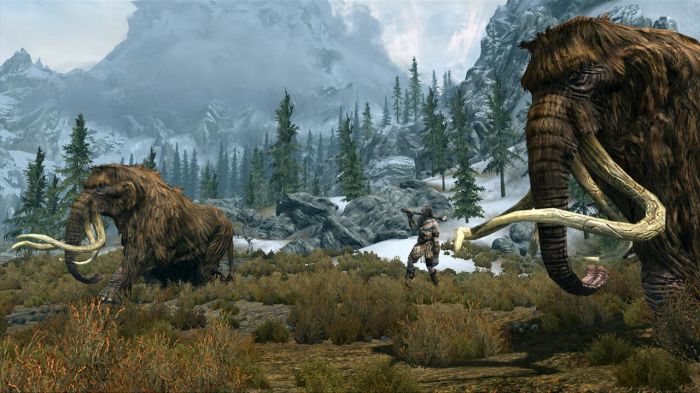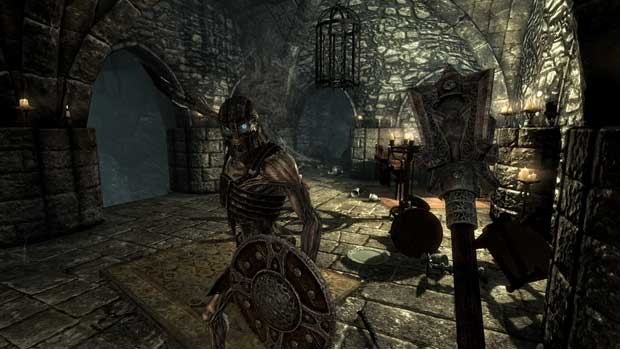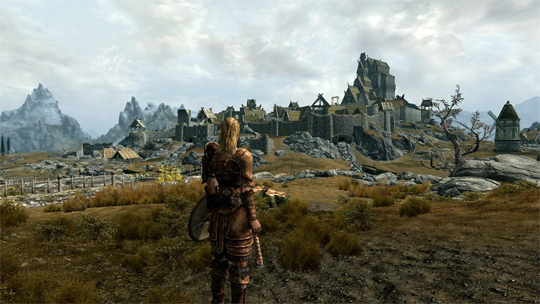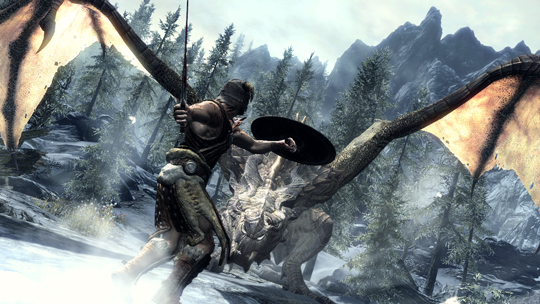
Perhaps what Bethesda does best is immerse players in rich worlds that afford the opportunity to explore freely and let the game experience emerge naturally. In Elder Scrolls V: Skyrim, the feeling of finding one’s own path through such a world seems to be pervasive. A short demonstration at this year’s E3 revealed much of what players can expect on November 11th, and from what we’ve seen, players can expect a lot.
Skyrim is the northernmost area of the Kingdom of Tamriel in Elder Scrolls lore. Tall pines, immense, craggy mountains, and broad valleys characterize the landscape, as if it were lifted directly from California’s Sierra Nevada or Europe’s Alps. It’s a beautiful world to dive into, and already illustrates the care the developers have put into its fine details in order to make it a rich, enveloping experience. The visuals at this point don’t appear to rival the best that is available on the technical end, but in terms of the whole package, from an artistic standpoint, little else is as impressive as what was shown in this E3 demo. Furthermore, the developers promise that every inch of the map will be traversable, right up to the highest mountain summit, which makes everything about Skyrim‘s visual presentation more meaningful in a ludic sense.

Some players will be more interested in the characters they create than in the world crafted for them by Bethesda. Skyrim takes a different, more organic approach to building a character than previous Elder Scrolls games, or most Western RPGs, for that matter. There is no class choice in Skyrim; characters begin as uncarved blocks and are shaped by their actions throughout play. Using spells to destroy enemies will improve magic abilities, blocking incoming strikes will increase shield proficiency, picking locks will enhance that skill, and so on. That is not to say that there is no outside influence on character development, though, as special stones placed around Skyrim can be activated to raise the rate at which specific class-related attributes grow. For example, a ranger stone might give the bonus to ranged weapons, light armor, and agility while it is active. Only one of these stones can be active at a time, a sensible and acceptable limitation, especially considering the new dual-wielding of both weapons and spells, the latter of which can be doubled up to boost their effects.
Character attributes are based on star signs, and Bethesda has created a new menu system to reflect that. Now, to view the various skills available in Skyrim, players look to the heavens for a full visual representation in the form of constellations, each of which denotes a particular attribute and associated skill tree. Inventory menus have changed, as well, and are now streamlined into nested lists, including a favorites section, with a 3D model and detailed information for each item. One notable category, and one that featured heavily in previous Elder Scrolls games, is in-game literature. There are over 300 books in Skyrim, each displayed as a 3D model with pages that turn on screen as if being handled by the character. Just the opposite is the map, which is no longer a standard part of the menu system. Instead, Bethesda’s new Creation Engine quickly pans all the way out to make what is essentially the equivalent of a satellite map out of the game world.

Skyrim is made up of five major cities and a number of minor towns, and each city has a working economy based on the businesses located there. Non-player characters have jobs and go about their daily routines without player interaction, but players can take up work of their own, like upgrading weaponry at a blacksmith’s or helping pull logs into place at a mill. It is even possible to sabotage these places, and consequently, a town’s economical well-being, if one were so inclined. Dialog plays a large role in players’ interactions with the world and its characters, and is now handled in real time; players are never forced into a static conversation situation; one can easily walk away from any NPC who proves boring or unimportant.
Player-characters themselves are quite special. They are are dragon kin, and are capable of building repertoires of special abilities called shouts, each arising from one of the "words of power" discovered in any of the game’s 150-plus dungeons. Word walls teach players ancient dragon writing that unlocks talents like fire breath, slowed time, a quick dash, a force-push-like maneuver, and storm call, which suddenly changes Skyrim’s weather and calls a thunderstorm to rain lightning bolts down on the enemy. Such higher-level shouts are made available by defeating dragons and absorbing their souls. Dragons sparsely populate Skyrim, but go wherever they please, so at any time, a significant "boss battle" with one that’s feeling feisty is a distinct possibility.

In terms of quests, Skyrim operates on what Bethesda is calling a "radiant story system." This means that any aspect of a quest can be altered depending on players’ past actions, adding more variety for those who play the game multiple times with different characters. Another interesting point about quests is that at least some of them appear to begin seamlessly when a player discovers the starting point, without the necessity of a quest-giving NPC.
From what was shown and explained at E3 2011, players should prepare for a deep, broad, immersive experience in the northern reaches of Tamriel later this year, and expect to spend many hours with their unique characters in The Elder Scrolls V: Skyrim. The game launches on November 11th on Xbox 360, PS3, and PC.

















